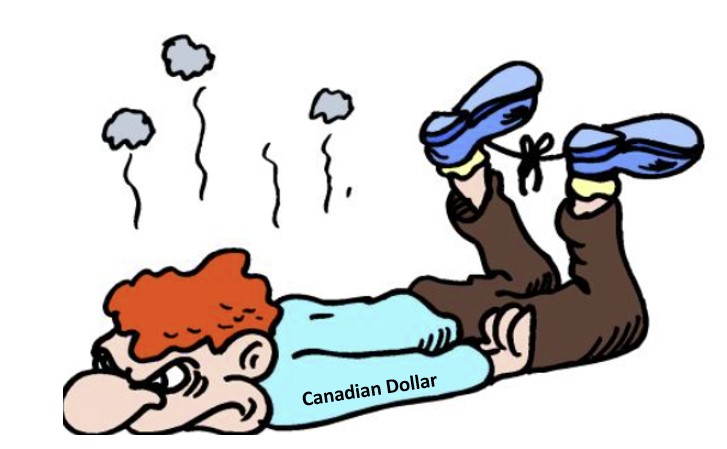
Photo: toppng.com/IFXA
By Michael O’Neill
The Canadian dollar is being incinerated after the Bank of Canada and Fed Chair Jerome Powell arrived at different conclusions from similar data.
The Bank of Canada left its benchmark overnight interest rate unchanged at 4.5%. Policymakers said they want time to assess the effectiveness of the previous 425 basis points of rate hikes in reducing inflation. They believe it’s rather simple: the aggressive rate increases will cause domestic growth to stall, allowing supply to catch up, which will relieve inflation pressures.
They stood pat despite admitting the labour market remained tight, noting strong employment growth, an unemployment rate near historical lows, and elevated job vacancies. They seemed smug that inflation eased to 5.9% in January (which is still 3x their target level) while noting price increases for food and shelter remain high.
But that’s ok; the results are in line with their expectations.
It’s different in America. Fed Chair Jerome Powell and his colleagues analysed similar economic data as in Canada (high employment, high inflation, and high job vacancies) and came to a different conclusion.
Mr. Powell told Congress that with inflation well above the target and the labour market extremely tight, it is appropriate for ongoing increases in the federal funds rate to levels higher than previously anticipated and possibly at a faster pace.
Who is right? Do you bet on the guy who told Canadians to strap on debt because rates would be low for a long, long time or the guy who successfully transformed himself from a dove to a fire-breathing hawk?
Perhaps there is a method to what appears to be BOC madness?
BoC officials rarely talk about the currency. In the quarterly monetary policy report (MPR), the bank says that “by convention, the bank does not forecast the exchange rate in the Monetary Policy Report.” They merely use the prevailing spot rate.
However, last month, Deputy Governor Paul Beaudry spoke at length about “different paths to normal.” He pointed out that since the Canadian dollar is a floating currency, it gives the bank the ability to chart a different path than the ones our trading partners take.
He commented, “Rather than trying to maintain a particular value for the dollar, the Bank can instead focus on setting interest rates to return inflation to 2.0%.” Mr. Beaudry then said, “Suppose we enter a period during which inflation is lower in Canada than it is in one of our trading partners. Over time, this difference in inflation would create a divergence in price levels between the two economies because the price of goods in Canada would be rising more slowly than the price of goods in the other country.
He went on to say that if exchange rates do not adjust, lower Canadian prices could improve our competitiveness as exports would be more attractive to foreigners, which is good for growth and job creation.
On the other hand, if the exchange rate does adjust, then reaching our inflation target sooner than our trade partners would lead to an appreciation of the Canadian dollar over time.
It is obvious that Beaudry is referring to the USDCAD exchange rate as America accounts for 73% of Canada’s trade volume. In January, the Canadian inflation rate was 5.9% year on year, while the US CPI rate was 6.4%.
Arguably, the BoC’s decision to leave rates unchanged is a deliberate decision to devalue the Canadian dollar.

Source: HDclipart.com
For starters, the federal government would prefer to see lower rates as the combined federal and provincial net debt-to-GDP ratio will reach 75% in 2023, up from the pre-pandemic level of 66%. The higher cost of servicing that debt means less money to alleviate the health care crisis in Canada.
A weaker Canadian dollar suggests higher demand for Canadian exports, mainly raw resources. Because those raw materials are priced in US dollars, resource companies will earn more money and the federal government will receive more royalties. A weaker Canadian dollar is also good for tourism. Canada could become a popular tourist destination, particularly for Americans looking to capitalise on the strength of the US dollar.
However, if the BoC truly desires a weaker currency, this appears to be a rather stupid plan.
Just ask Turkey’s President Recep Erdogan. His idea of beating inflation was to lower interest rates. USDTRY rallied 55%, and inflation is still around 60%. If the BoC‘s objective is to get inflation down to 2.0%, devaluing the currency is not the way to go.
Nevertheless, the BoC’s decision to leave rates unchanged while the Fed plans to continue raising rates to the 5.5–6.0% level, gave a green light to traders to sell Canadian dollars.
USDCAD soared from 1.3602 before Powell started talking on Tuesday to 1.3813 in New York on March 8. It is going to go higher, especially if the anticipated oil price rally fails to materialise in the next few months.
The technicals for the USDCAD are bullish while prices are above 1.3400, which is supported by the decisive break above 1.3660. A move above resistance at 1.3850, which has capped prices since June 2020, puts a target on the pandemic peak of 1.4630.
Chair Powell has lit the BBQ, and the loonie is on the spit.





